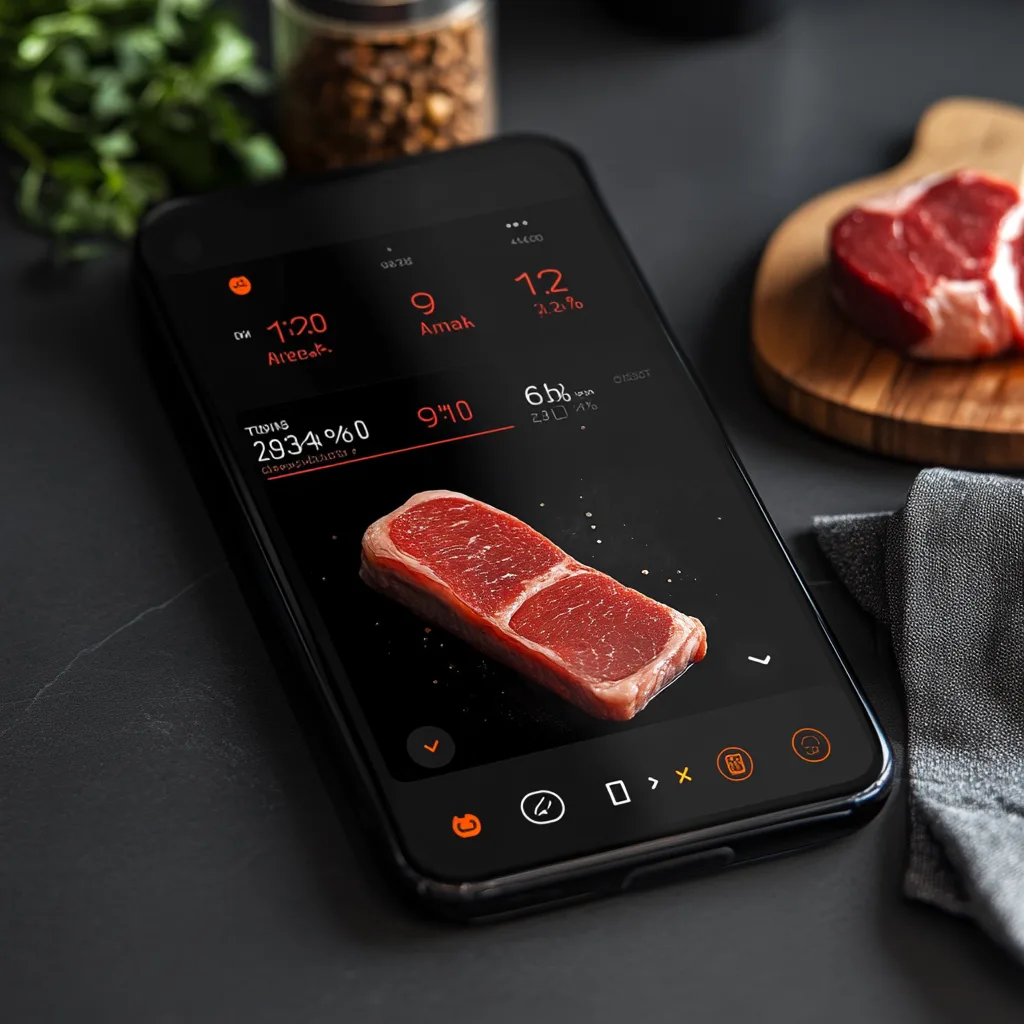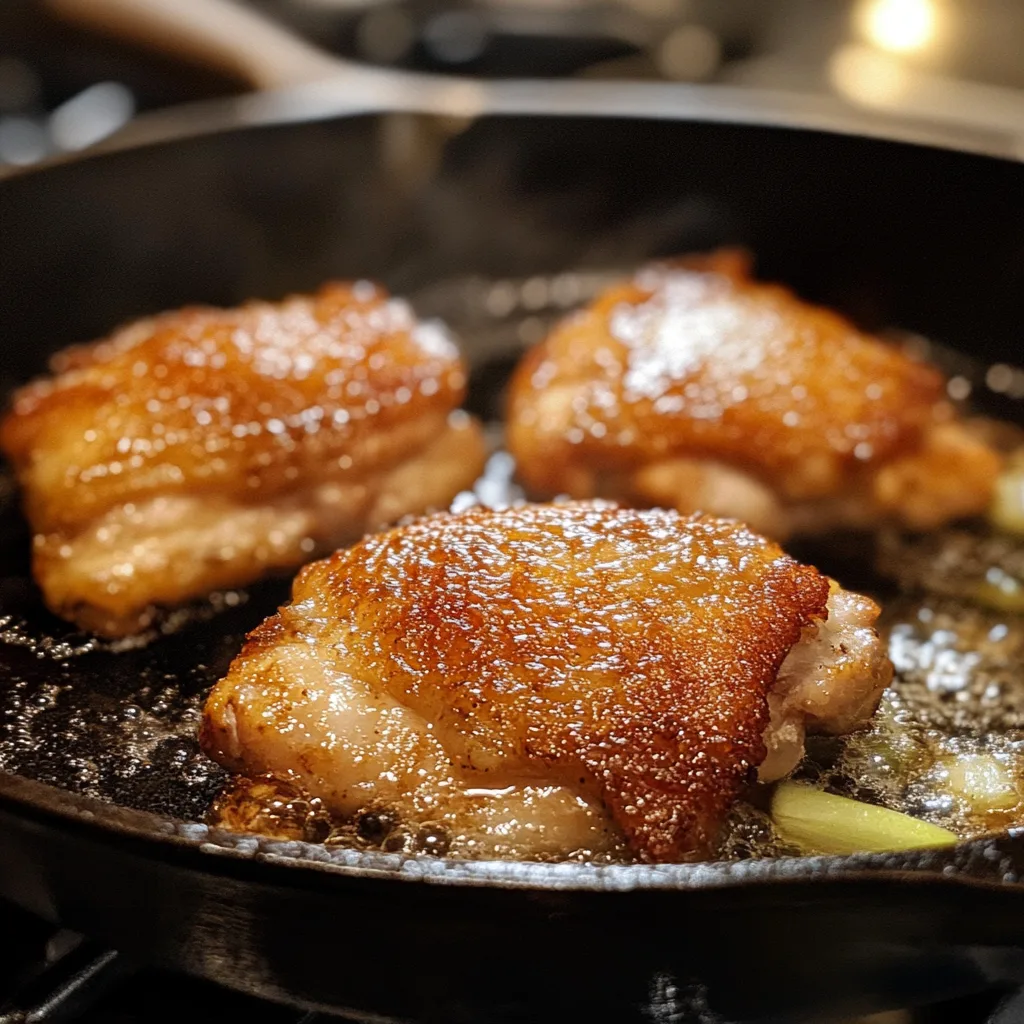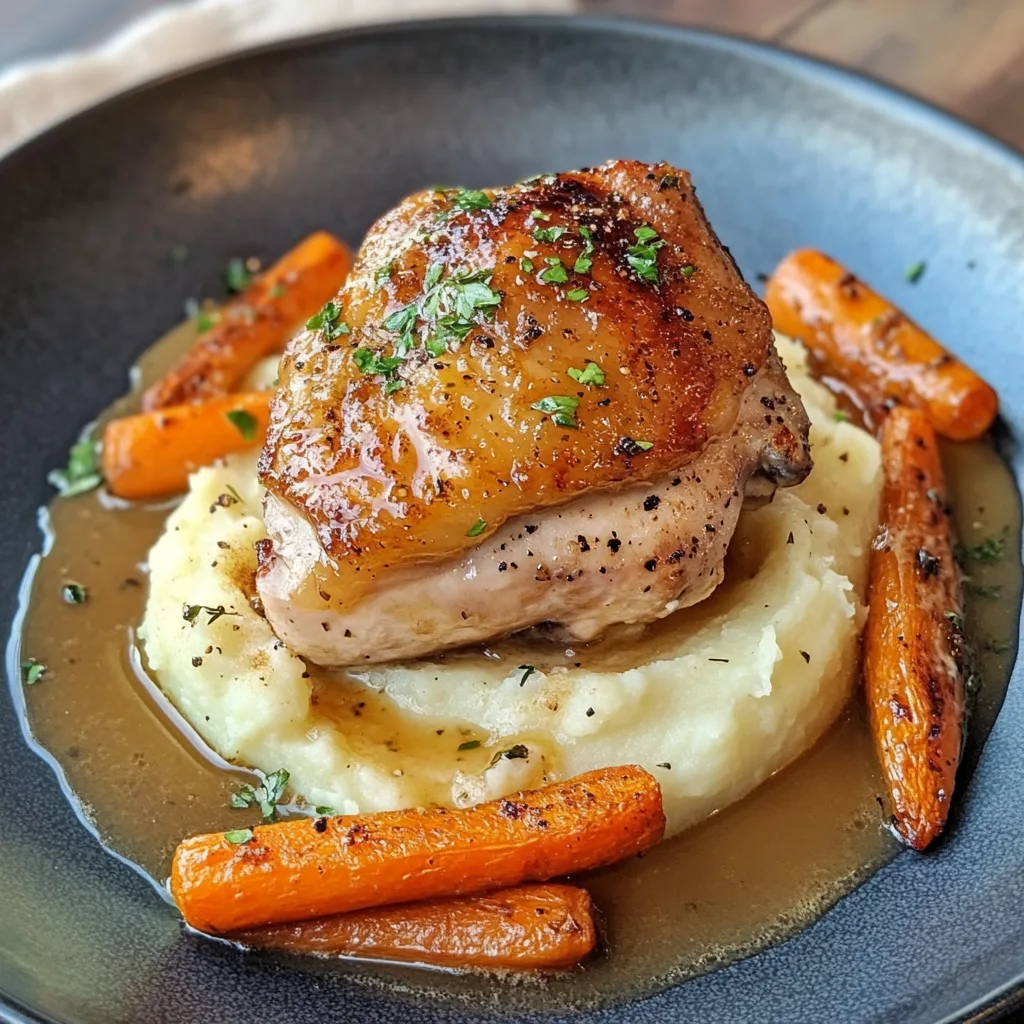Introduction
If you’ve ever struggled to cook chicken thighs that are juicy on the inside and crisp on the outside, you’re not alone. Whether they turn rubbery or dry, cooking chicken thighs just right can be tricky—unless you’re using sous vide. With this precise, low-temperature cooking method, you’ll never overcook chicken again. This guide dives deep into how to make perfect chicken sous vide thigh—from time and temperature tips to seasoning, searing, serving, and more.
Learn more about Sous Vide Filet Mignon to see how this method transforms steak too.
Why Choose Chicken Sous Vide Thigh for Your Next Meal?
What is Sous Vide Cooking and Why It Works So Well with Chicken Thighs
Sous vide (pronounced soo-veed) means “under vacuum” in French, and it refers to cooking food slowly in a water bath at a precisely controlled temperature. Instead of blasting chicken thighs at high heat in the oven or pan, sous vide brings them up to the perfect doneness gradually—never going a degree over.
Dark meat, like chicken thighs, contains more connective tissue and fat than chicken breast. This makes it ideal for sous vide because the gentle cooking process breaks down that tissue slowly, resulting in tender, juicy bites without drying out.
Sous vide cooking eliminates guesswork. You don’t need to slice into your chicken to check if it’s done—it’s perfect edge to edge.
Benefits of Sous Vide Over Traditional Cooking for Dark Meat
There are several reasons why home cooks and chefs prefer sous vide chicken thighs:
| Benefit | Description |
|---|---|
| Perfect Doneness | Whether you prefer it at 145°F or 160°F, the meat stays tender. |
| Zero Dryness | It retains all its juices inside the sealed bag. |
| Hands-Free | Once it’s in the bath, you don’t need to watch it. |
| Meal Prep Friendly | You can cook ahead, chill, and finish later. |
| Crispy Finish | A quick pan-sear after cooking gives you golden skin or a crisp crust. |
Looking for inspiration? Try our Rotisserie Chicken vs Chicken Breast Health comparison for nutrition ideas when planning your meals.
While oven-roasted and pan-seared thighs are classic, chicken sous vide thigh offers precision and consistency that traditional methods just can’t match.
Print
Chicken Sous Vide Thigh – How to Make It Juicy and Perfect Every Time
- Total Time: 2 hours 10 minutes
- Yield: 4 servings 1x
Description
Learn how to make the juiciest chicken thighs using sous vide cooking. This foolproof method locks in flavor, guarantees tenderness, and makes dinner prep effortless.
Ingredients
4 chicken thighs (bone-in or boneless)
1 tbsp olive oil or butter
¾ tsp salt
½ tsp black pepper
½ tsp garlic powder
2 sprigs fresh thyme or rosemary (optional)
Instructions
Preheat your sous vide immersion circulator to 145°F.
Season chicken thighs with salt, pepper, garlic powder, and olive oil. Add herbs if desired.
Place thighs in a vacuum-seal or zip-top freezer bag using the water displacement method.
Seal the bag and submerge in the water bath. Cook for 1.5 to 4 hours.
Once cooked, remove chicken from the bag and pat dry with paper towels.
Sear both sides in a hot pan for 30–60 seconds to crisp the outside.
Serve hot with your favorite side dish.
Notes
- For a firmer texture, increase temperature to 150°F.
- You can store cooked thighs in the fridge for up to 4 days or freeze for up to 3 months.
- Reheat sous vide at 130°F for 30–40 minutes.
- Prep Time: 10 minutes
- Cook Time: 2 hours
- Category: Main Course
- Method: Sous Vide
- Cuisine: American
Nutrition
- Serving Size: 1 thigh
- Calories: 280
- Sugar: 0g
- Sodium: 400mg
- Fat: 18g
- Saturated Fat: 6g
- Unsaturated Fat: 12g
- Carbohydrates: 0g
- Fiber: 0g
- Protein: 28g
- Cholesterol: 100mg
Keywords: chicken sous vide thigh, juicy chicken thighs, sous vide recipe
Preparing Chicken Thighs for Sous Vide Like a Pro
Bone-In vs Boneless: Which Is Better for Sous Vide?
When cooking chicken sous vide thigh, both bone-in and boneless cuts work beautifully—but each has its perks.
Bone-in chicken thighs tend to be slightly juicier. The bone helps conduct heat evenly and enhances flavor, making it perfect for a richer bite. However, the bone can slightly slow down heat penetration, so your cook time may lean toward the longer end (closer to 2+ hours).
On the other hand, boneless chicken thighs are more convenient. They cook evenly and are easier to portion and sear. Boneless options also absorb marinades better and have no bones to navigate during serving. If you’re planning to slice or shred, boneless is the way to go.
| Cut Type | Pros | Cons |
|---|---|---|
| Bone-in | More flavor, juicier texture | Slightly longer cook time |
| Boneless | Easier to serve, faster to prep | Slightly less rich in flavor |
Don’t miss our Chicken vs Pollo Asado Explained if you’re deciding between flavor-packed chicken styles.
How to Season Chicken Thighs for Maximum Flavor
With sous vide cooking, seasoning plays a crucial role since the meat cooks in a sealed environment. You want flavors that penetrate and complement the juicy texture.
Here are the essentials for flavor-packed chicken sous vide thigh:
Basic Seasoning Combo:
- Salt (¾ tsp per pound of chicken)
- Black pepper
- Garlic powder
- Olive oil
Pro Tips:
- Dry Brine: Salt your chicken and let it rest in the fridge (uncovered) for 2–4 hours before sealing. This helps moisture retention and enhances flavor.
- Herbs + Aromatics: Add sprigs of thyme, rosemary, or sage to the bag.
- Compound Butter: A pat of flavored butter (garlic-parsley or lemon-chili) inside the bag melts and bastes the chicken during cooking.
- Citrus Zest: Grated lemon or orange zest adds brightness and cuts through richness.
It’s best to vacuum seal your seasoned chicken thighs, but a zip-top freezer bag using the water displacement method works fine too.
Looking for flavor twists? Discover great ideas like this Grilled Butter Chicken Nutrients guide to explore global spice blends that pair well with sous vide cooking.
Best Time and Temperature for Chicken Sous Vide Thigh

Ideal Temperature Range for Juicy Chicken Thighs
When it comes to sous vide, temperature equals doneness. Chicken thighs have more fat and connective tissue than breasts, which makes them ideal for slow cooking over a wide range of temps. Unlike breasts, thighs can be safely eaten at lower temps—if held long enough.
Here’s a quick breakdown of temperature and how it affects the texture of your chicken sous vide thigh:
| Temp (°F) | Time | Texture Result |
|---|---|---|
| 140°F (60°C) | 2–4 hrs | Ultra tender, slightly soft |
| 145°F (62.8°C) | 1.5–4 hrs | Juicy, slightly firm |
| 150°F (65.5°C) | 1–3 hrs | Perfectly balanced texture |
| 160°F (71.1°C) | 1–2 hrs | Firmer, traditional bite |
| 165°F (73.9°C) | 1 hr | Classic “done” chicken |
145°F is the sweet spot for flavor and tenderness. It’s completely safe when held for at least 90 minutes, thanks to pasteurization.
Is it safe to sous vide chicken at 145? Absolutely. The USDA temp of 165°F assumes instant kill. Sous vide relies on time at temperature. Holding thighs at 145°F for 1.5 hours achieves the same level of safety with more juiciness.
Learn more about meat safety and time balance in our guide on Sous Vide Ribeye Steak.
Sous Vide Time Guide: From 1 to 6 Hours, What Changes?
You can hold chicken thighs in a sous vide bath for hours without drying them out—but it’s not unlimited.
- 1 to 2 hours: Standard cook time. Ideal for most textures and finishes.
- 3 hours: Slightly softer, good for shredding or when using bone-in.
- 4 to 6 hours: Results in super tender, fall-apart chicken. Use this for tacos or pulled-style meat.
- 6+ hours: Possible, but risks mushy texture. Use caution.
Can you sous vide chicken for 3 hours? Yes—and it’s often preferred for tougher or thicker bone-in thighs.
Don’t miss our Smoked Bacon-Wrapped Meatloaf for another low-and-slow protein option that pairs well with sous vide prep techniques.
Keep in mind that while sous vide gives you flexibility, going over 6 hours may negatively affect the texture—especially with boneless cuts.
Cooking Chicken Thigh Sous Vide Step-by-Step
Equipment You Need: Vacuum Sealer, Bags, Immersion Circulator
To prepare chicken sous vide thigh correctly, you need the right tools. While the method is beginner-friendly, having the right gear makes the process smoother and the results consistent.
Here’s a quick breakdown of essential sous vide gear:
| Equipment | Purpose |
|---|---|
| Immersion Circulator | Heats and maintains water at exact temp |
| Vacuum Sealer or Zip Bags | Removes air to ensure even cooking |
| Large Pot or Container | Holds the water bath for cooking |
| Binder Clips or Weights | Prevents bags from floating during cook |
| Tongs + Sear Pan | For safe removal and post-sous vide searing |
No vacuum sealer? No problem. Use heavy-duty freezer bags and the water displacement method: slowly lower your sealed bag into the pot until the water pushes air out, then zip it shut.
Step-by-Step Process to Perfect Thighs
Follow these steps to cook perfectly juicy and tender chicken thighs every time:
1. Prep the Chicken
Trim excess fat if needed. Season generously with salt, pepper, herbs, garlic powder, or marinade. Add a small pat of butter or drizzle of oil inside the bag for moisture and richness.
2. Bag It Properly
Place your chicken thighs in a vacuum bag (or zip bag). Keep them in a single layer to ensure even cooking. Add aromatics like rosemary, thyme, lemon slices, or crushed garlic for flavor infusion.
3. Seal the Bag
Use your vacuum sealer, or use the water displacement method with a zip bag. Make sure no air is trapped—floating bags lead to uneven results.
4. Heat the Water
Fill your container or pot with water and set your immersion circulator to the desired temp—145°F for tender and juicy or 160°F for a firmer texture.
5. Cook It Low and Slow
Once the water bath is ready, submerge the sealed bag. Clip the bag to the side so it doesn’t drift or float. Cook for 1.5 to 4 hours, depending on your preference and cut.
6. Remove and Pat Dry
After cooking, take the bag out of the water and carefully remove the chicken. Pat it completely dry with paper towels—this is crucial for getting that crisp sear later.
7. Finish with a Sear (Coming Next Part!)
Set aside your chicken—now it’s ready for a golden, flavorful crust. We’ll cover how to nail the final finish in Part 5.
Looking for a dessert pairing? Discover great ideas like our Three Ingredient Rice Pudding to round out your meal with ease.
Finishing Techniques: How to Sear or Crisp After Sous Vide

Pan Searing: Crispy Skin Without Overcooking
Once your chicken sous vide thigh is cooked to perfection in the water bath, it’s time to give it that irresistible, golden crust. But there’s a catch—if you’re not careful, you could ruin the precise doneness you just achieved.
Here’s how to sear properly:
Pan-Searing Steps:
- Preheat your pan – Cast iron or stainless steel works best. Heat it until just smoking.
- Use a high smoke point oil – Avocado, grapeseed, or canola oil prevents burning.
- Pat the chicken dry – Moisture = steam = no crust. Use paper towels and press firmly.
- Sear skin-side down first – For skin-on thighs, this gives maximum crispiness.
- Sear for 30–60 seconds per side – That’s all you need. Don’t cook it through again!
Add a small knob of butter and herbs at the end for a final flavor blast—baste the thighs quickly before removing from the heat.
Check out our Sous Vide Filet Mignon – Best Steak Ever for another guide on finishing techniques with finesse.
Broiler, Torch, or Grill: Which Gives the Best Result?
Not a fan of stovetop searing? No problem. You’ve got options for crisping up your sous vide chicken thighs while still keeping them juicy inside.
Broiler:
- Preheat your broiler to high.
- Place thighs on a wire rack over a baking sheet.
- Broil for 1–2 minutes per side—watch carefully to avoid burning.
Torch:
- Use a culinary torch for precision crisping.
- Perfect for skinless thighs or when targeting specific spots.
- Don’t overdo it—move quickly and evenly.
Grill:
- Preheat grill to high.
- Oil the grates to prevent sticking.
- Grill 1 minute per side for charred edges and a smoky kick.
Each method has its own perks. Pan searing is the most common, but torching and broiling are fantastic when you’re finishing multiple portions or want to avoid splatter.
Looking for another juicy, high-protein dinner option? Don’t miss our Venison Cube Steak Recipes—another great way to try new meats without sacrificing texture.
Flavor Variations and Marinade Ideas for Sous Vide Chicken Thighs
Lemon Herb, Teriyaki, Garlic Butter, and Spicy Cajun Profiles
One of the major advantages of sous vide cooking is that it locks in flavor. Since the chicken cooks in a sealed bag, the aromatics and seasonings don’t escape—they infuse directly into the meat. Here are some standout marinade and seasoning combos that work beautifully for chicken sous vide thigh:
Lemon Herb
A bright, zesty profile perfect for spring or summer meals.
- Ingredients: Olive oil, lemon zest, garlic, thyme, rosemary, salt
- Tip: Add a thin lemon slice inside the bag for extra citrus flavor
Teriyaki Glaze
Sweet and savory with a Japanese-inspired twist.
- Ingredients: Soy sauce, brown sugar, garlic, ginger, sesame oil
- Tip: Reduce the marinade into a glaze after sous vide for a sticky finish
Garlic Butter
Rich, comforting, and deeply flavorful.
- Ingredients: Butter, minced garlic, parsley, smoked paprika, salt
- Tip: Add compound garlic butter into the bag—it’ll melt and self-baste
Cajun Spice
Bold and spicy with a Southern flair.
- Ingredients: Paprika, cayenne, onion powder, garlic powder, oregano, salt
- Tip: Rub the spice mix directly onto the thighs before bagging for deeper flavor
Looking for more comfort food flavor combos? Check out our Ultimate Calico Beans Recipe to pair with smoky Cajun chicken thighs.
How to Safely Sous Vide with Marinades
Marinades are great, but not all are sous vide-safe. Acid-heavy marinades (like vinegar or citrus) can over-tenderize the chicken if left for too long, leading to a mushy texture.
Here’s how to do it right:
| Tip | Why It Matters |
|---|---|
| Use oil-based or butter-based marinades | They infuse flavor without breaking down meat |
| Add marinade just before sealing | Prevents over-marination or discoloration |
| Avoid raw garlic for long cooks | Can taste harsh—use roasted or powdered instead |
| Don’t over-salt | The closed environment intensifies seasoning |
Want to go bolder? Discover great ideas like Italian Eggplant Recipes that complement herbal or garlicky sous vide chicken meals beautifully.
For even more creative seasoning profiles, try combining global spice blends—think Jamaican jerk, Moroccan ras el hanout, or Indian tandoori. Just remember to scale the intensity since sous vide enhances every flavor element.
Serving Suggestions and Side Dish Pairings

Best Sides: Roasted Veggies, Risotto, Garlic Mash, or Salad
Once you’ve nailed the perfect chicken sous vide thigh, the next step is making sure it lands on the plate like a star. Pairing it with the right side dish enhances its texture, flavor, and overall balance.
Here are some crowd-pleasing options:
Roasted Vegetables
- Pair well with any seasoning profile (garlic butter, lemon herb, Cajun)
- Try: asparagus, carrots, Brussels sprouts, or sweet potatoes
- Drizzle with olive oil, salt, pepper, and a touch of balsamic before roasting
Creamy Risotto
- Ideal with teriyaki or garlic butter chicken
- Mushroom risotto or Parmesan lemon risotto creates a rich, creamy texture contrast
- Finish with a little truffle oil or fresh herbs
Garlic Mashed Potatoes
- A hearty, comforting classic that goes with everything
- Use roasted garlic for deep flavor and fold in heavy cream and butter
- Add crispy fried shallots on top for crunch
Fresh Seasonal Salad
- Keeps the meal light and balanced
- Arugula, spinach, or baby kale with vinaigrette offers acidity to cut the richness
- Toss with sliced almonds, goat cheese, or berries for added layers
Looking for even more pairing ideas? Learn more about combining flavors and textures with our Ultimate Branzino Recipe—it’s a great example of building a well-rounded plate.
How to Plate for a Restaurant-Style Meal at Home
Plating isn’t just for Instagram—it enhances the dining experience. A beautifully presented dish invites your guests (or your weeknight self) to enjoy each bite more fully.
Pro Plating Tips:
- Use white plates to make the colors pop
- Slice boneless thighs and fan them over the starch or greens
- Add a drizzle of finishing sauce or glaze around the plate edge—not over the meat
- Layer components vertically—risotto base, chicken on top, greens beside
- Top with microgreens or a sprig of herbs for a final flourish
Hosting a dinner party? Don’t miss our Ultimate Heart Cake Guide for dessert ideas that impress just as much as the entrée.
Common Mistakes to Avoid with Chicken Sous Vide Thigh
Overcooking Post-Sear, Seasoning Errors, Bag Leaks
Even though sous vide is a precise and forgiving method, there are a few things that can still go wrong—especially if you’re new to it. Here are the most common mistakes home cooks make with chicken sous vide thigh and how to sidestep them.
Over-Searing the Chicken
After sous vide, your chicken is already cooked perfectly. But a long or high-heat sear can take it past the ideal doneness and dry it out.
- Fix: Sear for 30–60 seconds per side, max. Preheat the pan and pat the chicken dry to speed up crust formation.
Underseasoning
Because sous vide intensifies flavors in a closed environment, some cooks skip seasoning—but that’s a mistake.
- Fix: Use salt, pepper, aromatics, and even compound butter inside the bag. Don’t rely solely on a finishing sauce.
Bag Floating
When your vacuum-sealed bag floats, it’s a sign of trapped air. This leads to uneven cooking.
- Fix: Weigh it down with a spoon, use a rack, or double-seal. The water displacement method works well if you don’t own a vacuum sealer.
Using Too Much Acid in Marinades
While lemon juice and vinegar are great flavor enhancers, they can make your chicken mushy if left too long in sous vide.
- Fix: Add acids in moderation and cook shorter times when using citrus-heavy marinades.
Discover great ideas like Fixing Thin Chocolate Gravy for another guide on troubleshooting common kitchen mishaps.
How to Fix Rubbery Texture or Pale Appearance
Rubbery Texture
This is usually due to too low a temperature for too long, or over-marination.
- Fix: Aim for 145°F–150°F for 1.5–4 hours. Avoid extended cooks unless you’re going for shredded or pulled textures.
Pale Skin After Cooking
Sous vide won’t brown meat—it’s a gentle, water-based method. So skin-on chicken will come out cooked but colorless.
- Fix: Always finish with a quick sear or broil to crisp and color the exterior. And always dry your chicken thoroughly before searing.
Want a visual meal transformation? Don’t miss our How to Eat Red Bean Rice Balls for tips on improving presentation and bite textures.
Storing, Reheating, and Meal Prepping with Sous Vide Chicken Thigh
Can You Freeze Sous Vide Chicken? Yes—Here’s How
One of the best things about sous vide is how well it fits into meal prep and long-term storage. Once you’ve cooked your chicken sous vide thigh, you can either serve it immediately or stash it away for later without sacrificing quality.
Freezing Instructions:
- Let the cooked chicken cool completely in its sealed bag.
- If needed, plunge the sealed bag into an ice bath to chill it quickly before freezing.
- Label with the date and contents.
- Store for up to 3 months in the freezer.
Frozen, cooked sous vide chicken is a meal prep game-changer. You can reheat it in the same bag straight from the freezer without thawing—just drop it into a 130°F–140°F water bath for about 30–45 minutes.
Want another great freezer-friendly recipe? Learn more about make-ahead dishes like our Tinis Mac and Cheese—perfect for pairing with sous vide chicken for kids and adults alike.
Best Practices for Reheating Without Drying Out
Reheating chicken can be tricky—especially if you don’t want it to turn rubbery. Sous vide makes it easy by reheating evenly and gently.
Reheat Like This:
- From fridge: Drop the sealed bag in a 130°F water bath for 30 minutes
- From freezer: Same temp, just go 45–60 minutes
- Avoid microwaving, which can undo all the moisture you worked so hard to lock in
And yes, you can re-sear your chicken after reheating if you want to refresh the crispy exterior—just make it fast to avoid drying it out.
Looking for inspiration? Try our Smoker Recipes Guide to explore more low-and-slow cooking methods that complement sous vide prep.
Using Sous Vide Chicken in Meal Prep
Sous vide chicken thighs are super versatile. Once cooked and cooled, use them in:
- Wraps and sandwiches
- Grain bowls with quinoa, farro, or couscous
- Sliced over salads
- Shredded into tacos, burritos, or enchiladas
- Stir-fried with veggies and rice
- Mixed into pasta or creamy sauces
Meal prepping with sous vide is a real time-saver—your protein is already cooked, moist, and full of flavor. All you have to do is reheat and serve.
If you’re just getting started with sous vide cooking, having the right tools makes all the difference. For consistent results, an immersion circulator like the Anova Culinary Sous Vide Precision Cooker is a top-rated choice that maintains perfect water temperature throughout the process. To keep your chicken fully submerged and cook it evenly, consider pairing it with the EVERIE Sous Vide Container with Lid and Rack, which is specifically designed for sous vide use. And for optimal sealing, the FoodSaver Vacuum Sealer Machine helps remove all the air from your bags—locking in moisture, seasoning, and flavor during the cook. These tools make the process easier, cleaner, and ensure that every chicken sous vide thigh turns out tender, juicy, and packed with flavor.
Frequently Asked Questions (FAQs)
How long do you sous vide chicken thighs for?
It depends on the texture you’re aiming for. Most cooks go with 1.5 to 4 hours at a temperature between 145°F and 160°F. If you’re using bone-in thighs, 3–4 hours will give you fall-apart tenderness. For boneless, 1.5–2 hours at 150°F is ideal for a juicy, sliceable finish.
Is it safe to sous vide chicken at 145?
Yes, absolutely. While traditional cooking calls for 165°F, chicken is safe at 145°F when held for at least 1.5 hours. The extended time at a lower temp pasteurizes the meat, making it fully safe to eat—and way more tender.
Can you sous vide chicken for 3 hours?
Definitely. In fact, 3 hours is often the sweet spot for sous vide chicken thighs, especially if you’re working with bone-in cuts or want shreddable results. Just be sure not to go much beyond 6 hours, or the texture can get too soft.
Are chicken thighs done at 145?
Yes—if you hold them at 145°F for a minimum of 90 minutes. The internal temperature makes them safe to eat, and the slow, precise cooking keeps them incredibly juicy. For a firmer bite, try 150°F to 155°F.
Conclusion
Sous vide cooking is a game-changer—especially when it comes to chicken thighs. With precise temperature control, you get juicy, tender, and flavorful chicken every single time. Whether you like it shredded, sliced, or seared to a crispy finish, chicken sous vide thigh gives you total control over the result.
With proper prep, seasoning, and finishing techniques, it’s easy to elevate a basic ingredient into a gourmet dish that’s perfect for meal prep, dinner parties, or busy weeknights.
Don’t miss our guide on Sous Vide Filet Mignon – The Best Steak You’ll Ever Make for more sous vide mastery.
